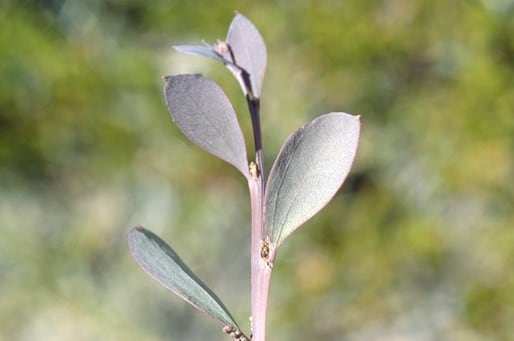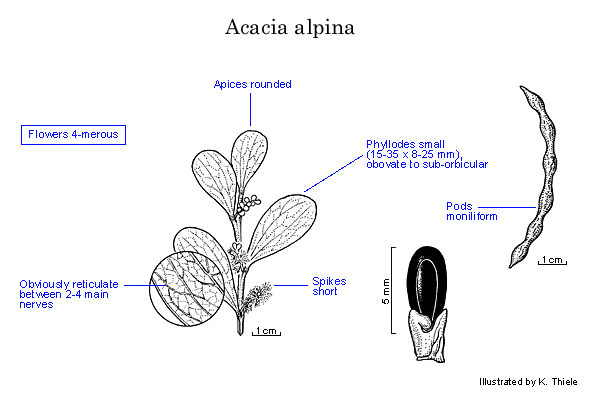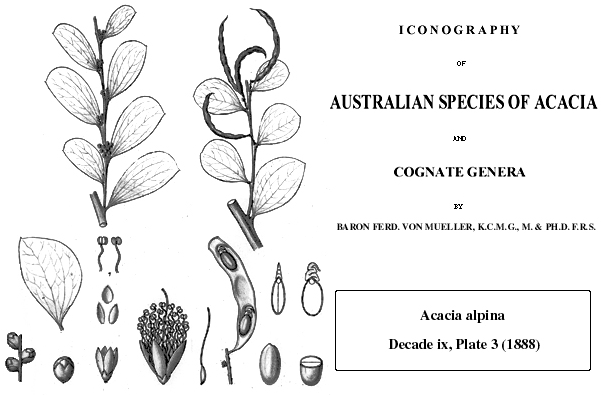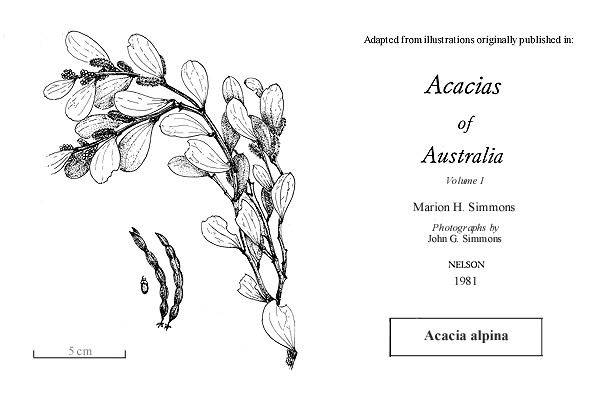Acacia alpina F.Muell.
WATTLE
Acacias of Australia
Common Name
Alpine Wattle
Family
Fabaceae
Distribution
Occurs in woodlands and heathlands and on open plains in the Snowy Mtns, N.S.W. and southern A.C.T. and extends to Mt Baw Baw in the eastern highlands of Vic. where it is sometimes locally common.
Description
Shrub 1–2 m high and 1–10 m wide, sometimes almost prostrate, tangled. Branchlets glabrous. Stipules caducous, deltate, 0.5–1 mm long. Phyllodes normally obovate or suborbicular commonly asymmetrical, 1.5–3.5 (–4.5) cm long, 8–25 (–27) mm wide, with a rounded (not mucronulate), straight, occasionally emarginate apex, coriaceous, dull green to dull grey-green or greyish; primary nerves 2–4; secondary nerves anastomosing and conspicuous; gland small or obscure, 2–9 mm above phyllode axil; pulvinus present. Inflorescences with peduncles 1–4 mm long and glabrous; receptacles glabrous; spikes solitary or twinned, oblong or cylindrical, 5–15 mm long, interrupted, pale yellow, sometimes bright yellow; bracteoles cymbiform, 0.4–1 mm long, 0.3–0.8 mm wide. Flowers 4-merous; sepals united. Pods submoniliform or occasionally linear, gently curved or coiled, thin-walled, 3–8 cm long, 3–6 mm wide. Seeds narrowly elliptic, 3.5–5 mm long; funicle folded 3–8 times; aril turbinate.
Habitat
It occurs most frequently in granitic tracts and seems to be confined to habitats between 1300 and 1800 m altitude. Sometimes it thrives well in windswept areas and occasionally forms impenetrable thickets.
Specimens
N.S.W.: below Blue Cow, Mt. Kosciusko area, M.Gray & C.J.Totterdell 6456 (CANB, MEL). A.C.T.: Sentry Box Hill, I.R.Telford 8589 (CANB, NSW). Vic.: Mt St Bernard, Jan. 1900, J.H.Maiden s.n. (HO, NSW); The Big Plain, 3 km NW of Mt Wellington, T.B.Muir 3737 (MEL).
Notes
A member of the ‘A. longifolia group’ related to A. phlebophylla with which it sometimes putatively hybridizes in Vic., e.g. at Mt Buffalo where it co-occurs with both parents (N.G.Walsh 5163, MEL). Acacia alpina is distinctive on account of its ovate or suborbicular phyllodes, its low, intricate and tangled habit and its preference for alpine and subalpine habitats.
FOA Reference
Data derived from Flora of Australia Volumes 11A (2001), 11B (2001) and 12 (1998), products of ABRS, ©Commonwealth of Australia
Author
A.B.Court
Edited by B.R.Maslin
This identification key and fact sheets are available as a mobile application:
URL: https://apps.lucidcentral.org/wattle/
© Copyright 2018. All rights reserved.













